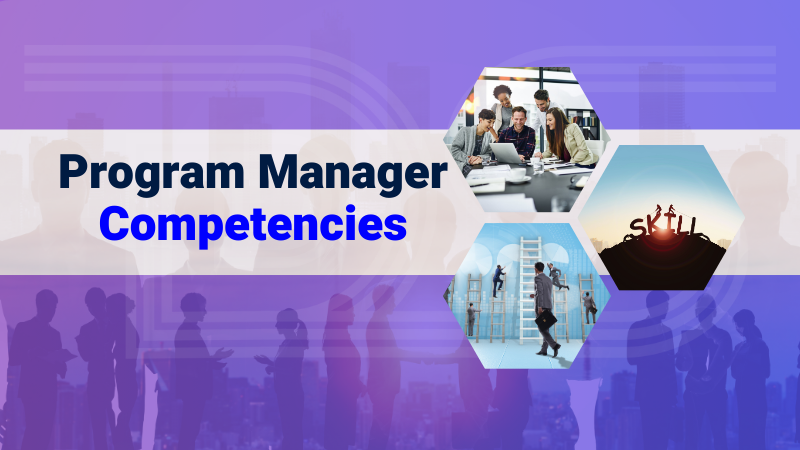
by DharamCW | Aug 1, 2024 | General
Today’s organizations are structured through many time-limited programs that transform organizational strategy into action. These programs necessitate a visionary mindset to align program goals with the organization’s strategic objectives. While project managers direct project work, they ensure individual projects align with program goals. Thus, program managers see their role as strategic and play an important role in managing the implementation of the organization’s strategic objectives by ensuring that the overall mission is met through the successful completion of planned programs.
Core Competencies of Program Managers
There are many similarities between a good program manager and a good project manager. However, a program manager must have broader organizational knowledge than a project manager. In addition, programs frequently necessitate strategic visioning and planning skills to align overall program goals and benefits with the organization’s long-term goals.
Here are the top ten core competencies of Program Managers:
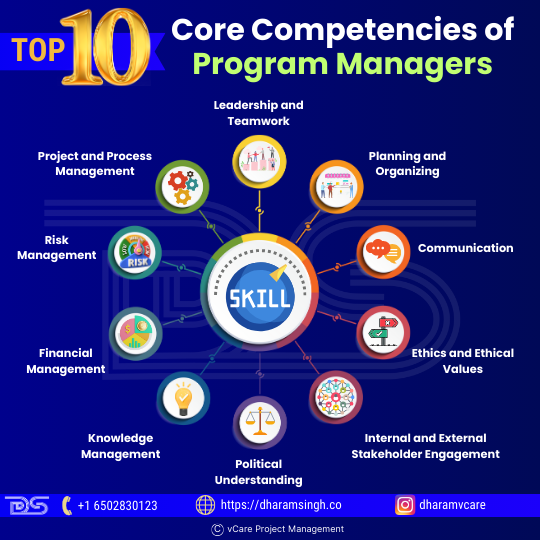
Top 10 Core Competencies of Program Managers
1. Leadership and Teamwork
The program manager is the team’s leader and is accountable for the program’s overall success. As a result, it is critical to have a clear vision and the ability to communicate it effectively to all employees, whether charismatic, supportive, or inspiring. The program manager’s strong leadership provides direction, builds morale, and inspires the program and project teams.
As the team leader, the program manager is responsible for engaging all team members and fostering collaboration, individual commitment, and accountability. A program manager must decide which tasks can be assigned and who can delegate them. Understanding what to delegate and how to delegate is critical.
2. Planning and Organizing
Programs frequently necessitate strategic visioning and planning skills to align overall program goals and benefits with the organization’s long-term goals. Therefore, the program manager must be skilled at planning and organizing for the best outcomes. Aside from the program schedule, creating a Work Breakdown Structure (WBS) for the program at the summary level is critical. It also allows control accounts to manage cost, schedule, and scope. In addition, a well-designed Work Breakdown Structure (WBS) helps organize the team at the start of a program and makes change management easier.
3. Communication
A program manager must be a good communicator. Effectively moving information between project resources is critical to a program’s success. To ensure the success of the team and project, the program manager must be able to negotiate effectively and use persuasion when necessary.
Thus, effective communication entails breaking down barriers within and across projects and functional departments.
Communication “hard skills” include gathering and disseminating performance data, such as status reports, progress measurements, and forecasts. In addition, the program manager must communicate effectively with the program and project teams, top management, and stakeholders. For the project’s success, vertical and horizontal communication must be fluid and transparent.
4. Ethics and Ethical Values:
One of the key aspects of effective program management is ethics.
The Code of Ethics & Professional Conduct emphasizes ethical values such as trust, honesty, accountability, respect, and fairness—these five values foster team harmony and professionalism, which leads to project success. Building trusting relationships across cultures, time zones, teams, and departments aids in the smooth operation of projects.
Trust is the common thread that connects different cultural differences, disparate work cultures spanning multiple time zones, team members with different behaviors, and departments with distinct objectives. A project leader must grasp this and cultivate trustworthy relationships.
Treating people fairly and demonstrating responsible, ethical behavior toward subordinates creates a working environment where employees feel safe, protected, and confident that there is no room for injustice or discrimination.
5. Internal and External Stakeholder Engagement
The program manager must be able to focus on both internal and external stakeholders simultaneously. Identifying and documenting all individuals or organizations impacted by the program and its projects and pertinent information about their interests and involvement significantly impacts program and project success. This process enables dealing with internal stakeholders (other project managers, senior managers, and the like) and external stakeholders (other agencies and regulators).
6. Political Understanding
Another skill that the program manager must have is the ability to understand the organization’s political environment. This understanding includes the political aspects of networking and strategic thinking to make the best decisions. With a solid understanding of the political environment, the program manager must form positive relationships to realize the program’s full benefits when the activities are transitioned to gain leverage and buy-in for overall program success. According to PMI’s The Standard for Program Management, well-managed stakeholder expectations and established buy-in can ensure program success. Knowing the firm’s working dynamic and environment is critical to the program manager’s success.
7. Knowledge management
A successful program manager should have a solid understanding of the organization and its business practices and familiarity with the technologies used in the program’s projects. In addition, program managers must have “hard skills” such as technical expertise and detailed cross-functional knowledge. This knowledge keeps the PM from being unduly influenced by functional experts who either have a plan or make decisions based on limited information.
The program manager is responsible for interpreting, implementing, and reviewing program policies, procedures, and requirements and communicating these to all program team members and project managers.
8. Financial Management
In today’s environment of scarce and competitive resources, program managers must understand how to finance their programs with speed, economy, and efficiency. Program managers are in charge of budgeting and calculating the return on investment (ROI). Therefore, they must be familiar with the program’s financial aspects to keep the budget under control at all times. In addition, they will be required to make decisions that will directly impact the budget and ROI for all projects within the program; therefore, program managers must be knowledgeable about the financial issues involved.
9. Risk management
Program management works tirelessly to reduce business risk. However, a project with no risk has little potential for reward. Effective risk management necessitates identifying risks, assessing their potential for harm, and developing plans to address the threats. Program managers are in charge of gathering all risks from functional teams and leading the team through a risk analysis exercise to determine which risks are program-level and project-level.
The program risks are then classified and prioritized based on their potential impact on the program. Finally, a similar exercise is performed to mitigate project risks throughout the life cycle to reduce overall program risk.
10. Project and Process Management
Transitioning from project management to program management necessitates a greater emphasis on the horizontal domain and less on technical capabilities. This action requires the program manager to prioritize strategic efforts over tactical skills, which can be delegated. Therefore, the program manager must have excellent project and process management skills, ideally with prior project management experience.
Managing program complexity through efficient and effective project management is critical for program management. Program management imposes structure and provides a framework that breaks down the complexity of managing a group of dynamic, time-limited projects into more manageable and cost-effective elements. This framework is critical for planning, scheduling, budgeting, and quality control. In addition, a program manager with strong core project and process management competencies can successfully lead between and across multiple projects.
Leadership Styles for Future Project/Program Managers
One of the potential success factors for both program and project managers is leadership style. A project manager can become a great project leader by understanding leadership styles and their impact. As a result, the program and project managers must determine the best leadership style for each project team. Some of the most common project management leadership styles are:
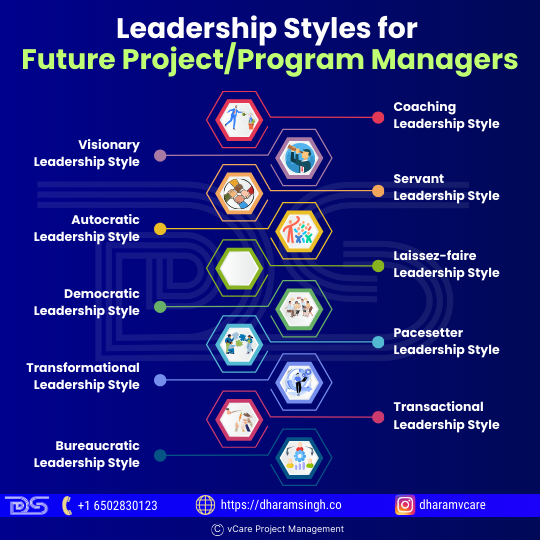
Leadership Styles for Future Project/Program Managers
1. Coaching leadership style
The coach’s leadership style is one of the most advantageous to employers and employees. But unfortunately, because it takes more time than other types of leadership, it is also one of the most underutilized.
2. Visionary leadership style
A visionary leadership style is advantageous for small, rapidly growing, and larger organizations undergoing transformations or corporate restructuring.
3. Servant leadership style
Servant leadership is an excellent leadership style for organizations of any size or industry, but it is especially common in non-profits. These leaders excel at boosting employee morale and reinvigorating employees’ interest in their work.
4. Autocratic leadership style
Autocratic leadership can benefit organizations with strict guidelines or industries that rely heavily on compliance. It can also benefit employees who require extensive supervision, such as those who need more experience. However, this leadership style can stifle creativity and make employees feel confined.
5. Laissez-faire leadership style
Unlike autocratic leadership, laissez-faire leadership focuses on delegating many tasks to team members and providing little supervision. Furthermore, because a laissez-faire leader spends less time managing employees, they often have more time to devote to other projects.
6. Democratic leadership style
The democratic leadership style is a hybrid of autocratic and laissez-faire leadership styles. Before making a decision, a democratic leader solicits and considers feedback from their team. This style is frequently credited with increasing employee engagement and workplace satisfaction because team members believe their voices are heard, and their contributions are valued.
7. Pacesetter leadership style
One of the most effective ways to achieve quick results is to set the pace. Pacesetter leaders are mainly concerned with performance, frequently setting high expectations and holding their team members accountable for meeting them.
8. Transformational leadership style
Like the coaching style, the transformational style emphasizes clear communication, goal-setting, and employee motivation. However, the transformational leader is motivated by a commitment to organizational objectives rather than putting most of one’s energy into each employee’s goals.
9. Transactional leadership style
A transactional leader, similar to a pacesetter, is laser-focused on performance. Under this leadership style, the manager establishes predetermined incentives, usually monetary rewards for success and disciplinary action for failure. However, unlike pacesetter leaders, transactional leaders are equally focused on mentorship, instruction, and training to achieve goals and reap the rewards.
10. Bureaucratic leadership style
Bureaucratic leaders, like autocratic leaders, expect their team members to adhere strictly to the rules and procedures. The bureaucratic style focuses on fixed duties within a hierarchy. Each employee has a set list of responsibilities, and collaboration and creativity are not required.
Adapting Agility during Digital Transformation
Thriving in today’s competitive environment is a difficult task. Businesses must find ways to keep up with the trends as almost every industry is rapidly evolving, fueled by technological advances. As a result, many adopt an agile mindset to remain sustainable and efficient.
The ability of a company to change or adapt quickly to market changes is referred to as business agility. The idea is to manage operations and resources flexibly and responsively to maximize business value. Concurrently, digital transformation is upgrading business processes using modern technologies to improve performance and overall efficiency.
Based on the agile project management philosophy, the business approach is gaining traction among forward-thinking organizations. It enables them to recognize and capitalize on potential opportunities ahead of the competition. Companies concentrate on three key areas for improvement:
• Strategy
• Organization
• Operations
Business agility is no longer an option in the age of digital transformation. Instead, it is an essential component of any successful business. As technology changes the world at breakneck speed, the program manager must be adaptable and develop alongside it.
Are Program Managers adapting to the agile environment?
Traditional project management entailed following a pre-defined plan to achieve pre-defined goals. However, in an agile environment, the concept of “done” is rapidly becoming obsolete. So, what does it take to manage projects effectively with constantly shifting requirements?
• Managers must first understand their organization’s goals when implementing agile workflows.
• Following that, they must reconsider their success metrics: rather than meeting a predetermined budget, timeline, or scope of work, project managers should focus on metrics such as development cycle time and the proportion of decisions made based on objective data.
• Finally, agile project managers must continuously examine their processes and seek to adapt and improve themselves to meet the evolving needs of their customers and coworkers.
Skills for a Hybrid Working Environment
Flexibility takes many forms as the world enters the “new normal” of business. However, the new flexible work models present some difficulties. To be successful in hybrid work, specific skills are required. Here is a list of five skills to concentrate on as you prepare for the new work environment.
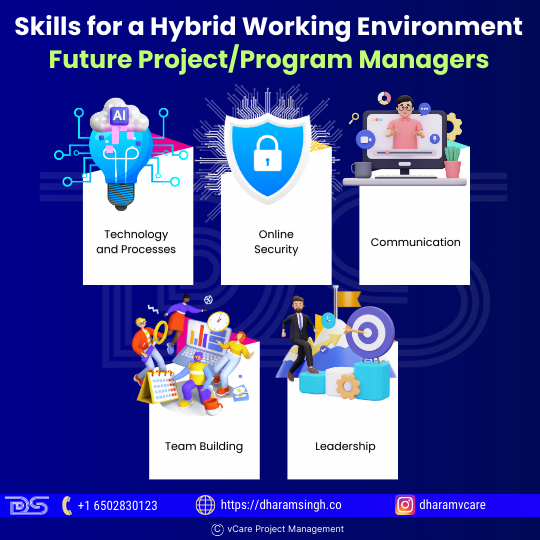
Skills for a Hybrid Working Environment
1. Technology and Processes
2. Online Security
3. Communication
4. Team-Building
5. Leadership
Every organization’s flexible work patterns look different. Additionally, there is no “one-size-fits-all” approach to implementing a hybrid work model. But, regardless of the circumstances, one thing is certain: training will be critical to your success.
Relevant information is critical. The right delivery methods are also important if you want them to stick. Finally, reaching and engaging your employees is critical to providing meaningful training. Use the best digital solutions to level the playing field for both in-office and remote employees. No matter where your employees are, the right approach will set them up for success.
Significance of Upskilling Project/Program Managers
Project/Program managers are valuable professionals who can work in various industries. It is frequently a highly sought-after position with numerous responsibilities. According to a study by PricewaterhouseCoopers, project management is critical to business performance and organizational success for 97% of organizations.
To ensure that a project management career takes off, one must have a mix of technical and soft skills. The top eight skills are listed below.
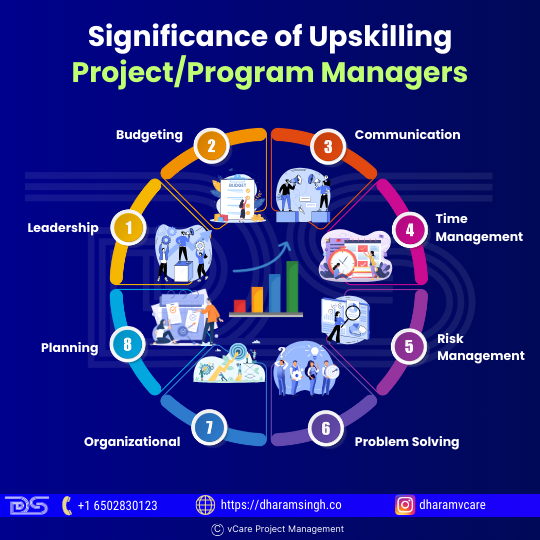
Significance of Upskilling Project/Program Managers
• Leadership
• Budgeting
• Communication
• Time Management
• Risk Management
• Problem Solving
• Organizational
• Planning
The world of project and program managers has changed significantly in the last few decades, with increased competition and the drive for efficiencies forcing companies to work differently. As project managers advance in their careers, they gain experience managing multiple related projects and making decisions that advance strategic and business objectives. As employers seek program managers to support the organization’s strategic goals, PgMP® credential holders will have a distinct advantage in employment and promotion opportunities over their peers.
How PgMP aids in gaining program managers’ knowledge
The Program Management Professional (PgMP®) certification is a visible indication of advanced experience and skill. As a result, it gives one distinct advantage in employment and promotion. As on 6th June 2024, there are 6,358 PgMP® that exist worldwide. The PgMP® is intended for professionals who have advanced in their careers and can manage multiple projects to ensure the success of a program. Furthermore, PgMP® holders are expected to manage complex tasks across multiple organizations, geographic locations, and cultures.
PgMP® Certification Benefits
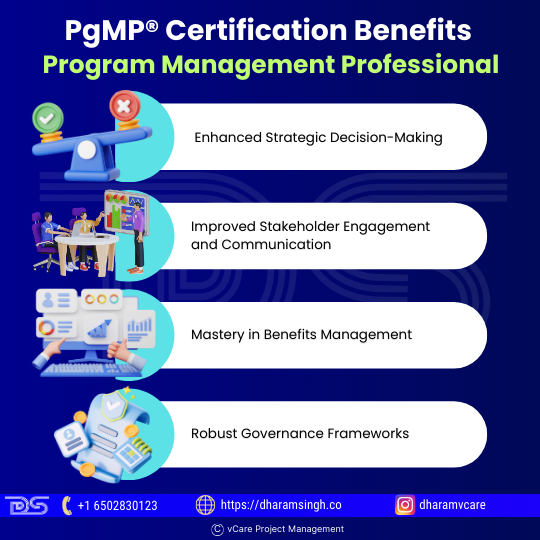
PgMP Certification Benefits
Enhanced Strategic Decision-Making:
The PgMP® certification equips program managers with the skills to make strategic decisions that align with organizational goals, ensuring the successful integration and delivery of multiple projects.
Improved Stakeholder Engagement and Communication:
Certified PgMPs are trained to effectively engage and communicate with stakeholders at all levels, fostering trust and ensuring stakeholder needs are met throughout the program lifecycle.
Mastery in Benefits Management:
Gain expertise in identifying, planning, and realizing program benefits, ensuring that the program delivers measurable value to the organization and its stakeholders.
Robust Governance Frameworks:
Learn to develop and implement robust governance frameworks that ensure program alignment with strategic objectives, risk management, and compliance with organizational standards.
Also, while preparing for PgMP® Certification, you will learn the best practices for conducting your programs more efficiently and achieving great results for your organization. This aspect might assist you in securing better pay and a higher position. In addition, you will be recognized as a certified program manager.
Final Thoughts
Program management will only be effective if the anticipated benefits are realized and effective leadership is at the top. Often, programs fail to achieve the organizational goal due to a lack of management skills in dealing with the program’s complexity and demand. Competence and skills are entirely different concepts, with skills acquired through training and competence referring to the level of proficiency in applying the acquired skills. The skills and competencies of a program manager and a project manager are similar. Still, those of a program manager are expected to be deeper and much more strategic in aligning a series of projects.
When program managers use their unique perspectives and insight to guide programs in the most strategically advantageous way, they can provide long-term value for the company’s vision and direction. Any organization that manages more than one project at a time will benefit from the assistance of a program manager.
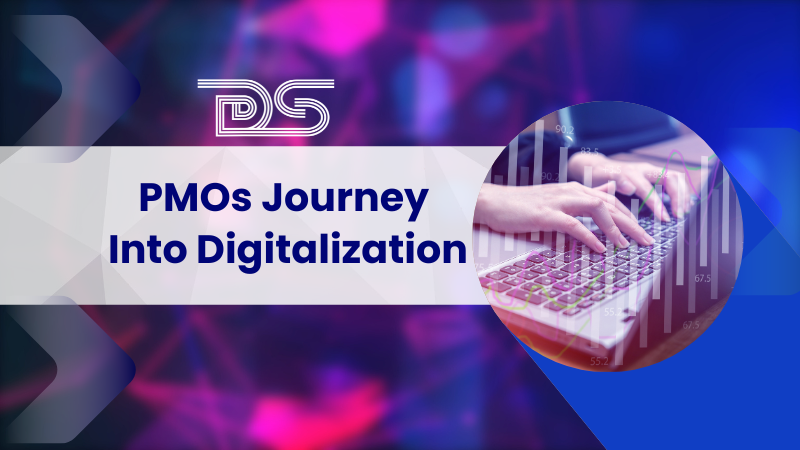
by Dharam CW2 | Jul 11, 2024 | General
Many PMOs recognize digitalization as an essential step in their organizations’ journey toward project management maturity. As a result, the Project Management Office (PMO) must shift its focus from project governance and delivery to supporting digital transformation.
To keep up with the evolving demands and needs of an increasingly digitized world, digital transformation has to be drifted through organizations of all shapes and sizes. However, many realize that successful digital transformation entails changing foundational cultures, structures, and methodologies and implementing digital tools. As organizations expand to accommodate this change, the PMO’s role within those organizations must change to do the same.
Digitalizing PMOs
Digital transformation is a familiar idea. Businesses constantly look for new ways to adapt and leverage emerging technologies to improve their business processes. Before the pandemic, PTC research found that 70% of organizations had or were working on a digital transformation strategy.
The PMO is crucial to achieving an organization’s strategic goals. If PMOs are to be an organization’s strategic drivers, they must expand their role beyond its traditional boundaries. They must assume their strategic role by leading change and capitalizing on opportunities in the digital space. PMOs must be at the forefront of emerging technologies, constantly evaluating opportunities and implementing new strategies. The recent pandemic and sudden shift to remote work have highlighted the challenges of developing community and culture through digital spaces. Here are some ways that PMOs can help the organization drive into digital transformation.
Five ways the PMO drives digital transformation
- PMOs can inspire and encourage change.
- PMOs act as the strategic arm
- PMOs provide support and insight.
- PMOs properly manage transformations.
- PMOs enable successful digital adoption.
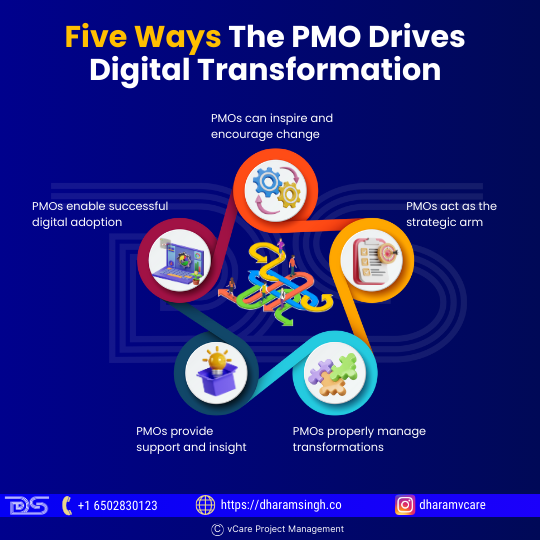
Five ways the PMO drives digital transformation
How PMOs can aid an organization’s digital transformation
The nature, ownership, and stakeholders of IT strategy, governance, and management activities are changing dramatically due to digitization. According to Gartner research, 87% of organizations prioritize digitization. Furthermore, technology is now responsible for 77% of an executive’s top priorities.
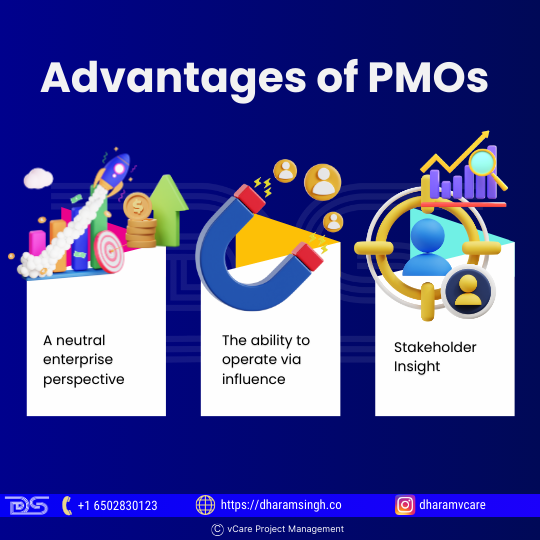
Advantages of PMOs
As a result, PMOs are under intense pressure to transform. Unfortunately, their project, program, and portfolio management processes are designed for predictability and consistency rather than the speed and flexibility required to meet digital demand. Most PMOs have three significant advantages, which are either inherent due to the PMO’s role or location or have been developed through previous experience:
- A neutral enterprise perspective: As capital allocation and portfolio prioritization approaches change to enable the funding flexibility required for digital work, the PMO’s impartial, enterprise-wide perspective on demand, investment, and resource utilization is hugely valuable.
- The ability to operate via influence: As organizational boundaries become more fluid and who “owns” project management becomes less certain, influencing and enabling others, rather than direct ownership, becomes even more critical.
- Stakeholder insight: As digitization spreads throughout the business and accounts for an increasing proportion of work, there are more first-time stakeholders and greater stakeholder complexity for each piece of work. Understanding the preferences of these various stakeholders and experiencing synthesizing their feedback becomes critical in delivering results from digital work.
Elements Driving Digitalization
Traditional businesses worldwide have long recognized that digital transformation is the key to thriving in a fast-paced world. Digital transformation involves integrating digital technology into all aspects of a business. It fundamentally alters how businesses operate and provide value to customers. It increases efficiency, transparency, customer experience, employee engagement, and culture and saves time and money. Modern digital tools have elevated the project management process to new heights.
The following are the seven critical elements of a successful strategic digital transformation framework:
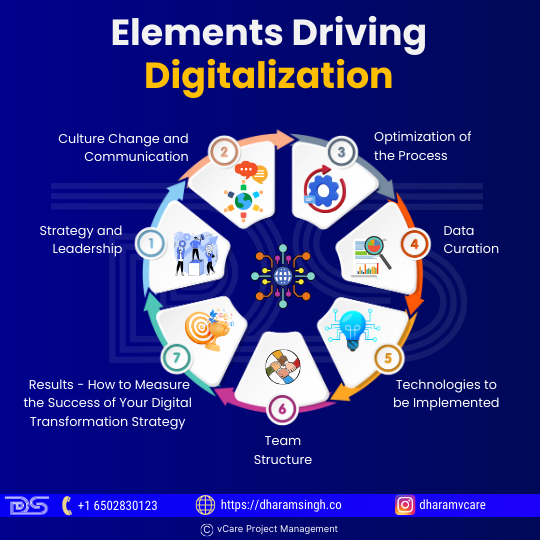
Elements Driving Digitalization
- Strategy and Leadership
An effective game plan is an obvious but frequently overlooked component of a digital transformation strategy. Instead, what matters is “how and who” formulates the strategy. A basic strategy and the appropriate technologies can help you digitize or digitalize your business, but transformation requires the right mindset and guidance. As a result, strategy combined with the right leadership is the first and most important component of an effective digital transformation strategy.
Visionary leadership combined with the appropriate digital transformation strategy can achieve a better, smoother, more cost-effective, and time-effective plan for your business’s transformation.
- Culture Change and Communication
Prepare for a massive cultural shift. A company’s clients and employees are typically resistant to significant changes, making implementing any transformation challenging. However, any successful digital transformation program must include culture. Therefore, giving your employees advanced training in good communication will be advantageous.
- Discuss the digital transformation strategy with your employees and how it will benefit all stakeholders.
- Conduct training sessions with your employees ahead of time to prepare them.
- You can prepare your employees by demonstrating the importance of aligning culture with new initiatives.
- Optimization of the Process
Every business has various processes and operations that can be improved to make workflows more efficient and effective. As a result, when developing a digital transformation strategy, consider business process optimization.
The strategy must optimize the business process while meeting customer and internal team goals. The digital transformation strategy must cover all interconnected business processes to achieve maximum output.
- Data Curation
One of the primary reasons for implementing digital transformation is to eliminate your business’s pain points for your team and your customers. But how will you know what these aches and pains are?
Data analysis and integration can assist you in locating them. People frequently choose their preferred technologies when developing transformation strategies before analyzing their data. Data analysis and the dissemination of its results can assist the team in identifying the best solutions to problems, leading to developing a better digital transformation strategy and making the most of the transformation process.
- Technologies to be Implemented
Finding the right technologies for your business is one of the most crucial steps in creating a digital transformation strategy. Introducing new technologies into your business will necessitate a significant financial investment, so it must be done correctly to avoid the need for additional funds. Any impactful strategy for digital transformation will always include options and budget constraints to help you make the best decision possible. Whether dealing with legacy system updates, application modernization, or implementing entirely new digital systems, you must find the best technology.
Some cutting-edge technologies that must be incorporated into your digital transformation strategy are:
- Cloud and Distributed Platforms
- Data Analytics & Artificial Intelligence
- Digital Experience and Digital Reality
- Team Structure
Harvard Business Review says digital transformation is about people, not tools. As a result, team structure is a determining factor in delivering results by the Digital Transformation Strategy.
The scope of the project should determine the team structure. The following components should be included in the digital transformation initiative:
- Pack of Leaders
- Business Experts
- The cast of Coders and Designers
- Results – How to Measure the Success of Your Digital Transformation Strategy
Your company’s digital transformation outcomes will greatly influence how you lay out your strategy. The outcomes will always vary depending on the practices and technologies used. Your digital transformation strategy’s success is dependent on its agility. First, of course, you must stick to your detailed strategy, but you must also be open to changes if things don’t go as planned.
By developing an effective, clear, and robust digital transformation strategy, you can ensure your company’s digital transformation goes as smoothly as possible. A digital transformation strategy is similar to a personalized road map for significant changes in your business operations. However, it requires significant financial investment, time, and technical expertise.
From Traditional PMO to Agile
Traditionally, PMOs have focused on maintaining project control to complete projects on time and within budget. However, in today’s increasingly complex and changing competitive environments, agile management is gradually displacing more traditional management methods; PMOs that remain anchored in this “classic” management model risk disappearing if they do not set the following objectives:
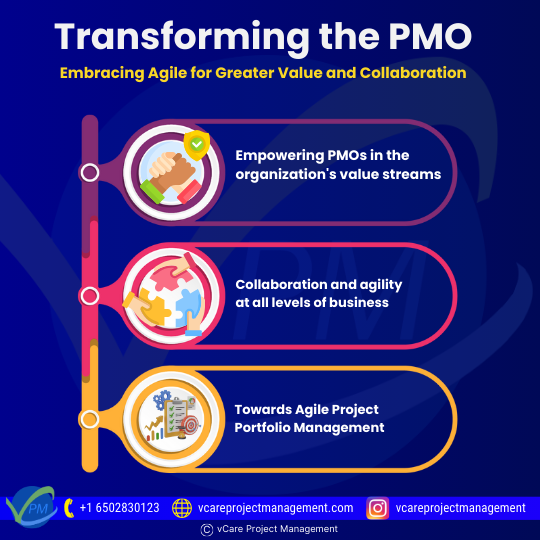
Transforming the PMO
- Empowering PMOs in the organization’s value streams
Organizations are now focusing on the value they provide to their customers and how different areas and departments contribute to that value creation. Suppose PMOs stick to their command and control model to ensure that projects are delivered on time and within budget. Their contribution to the organization’s value streams will be marginal, and senior management will view them as an unnecessary expense for the company.
- Collaboration and agility at all levels of business
Silo-based organizational models need to gain ground in agile and collaborative environments. As a result, PMOs must evolve beyond simply providing Project Managers with the tools they need to complete the organization’s projects.
On the one hand, PMOs must maintain open lines of communication with senior management to align the Project Portfolio with the organization’s goals. On the other hand, it serves as a reference point for stakeholders and project work teams, providing real-time information on project status and support at all levels for proper project implementation.
- Towards Agile Project Portfolio Management
Change is the norm in this new competitive environment, with highly volatile markets demanding businesses to bring products and services to market as quickly as possible. As a result, company objectives can shift dramatically quickly, necessitating a rethinking of project portfolio prioritization. This phase is where PMOs must adapt to this new environment and manage key project management issues like prioritization, resource management, budgets, or delivery dates in an agile manner, as well as learn to react to changes in their project portfolios in an agile and efficient way without losing sight of the organization’s objectives.
Post-pandemic challenges for PMO
If PMOs establish these three goals, they might avoid extinction because senior management will no longer recognize their value to the organization.
It will be challenging, and the Project Management Office will face several challenges as it adjusts to the new reality. In particular, the PMO will face some challenges for its role to be perceived as critical to the organization’s value streams:
- Coincide the project portfolio with the overall strategy of the organization.
- Resource management is a real challenge for PMOs.
- Responsiveness to changes in the project portfolio.
- Fluent in communication with the organization’s senior management.
- Embrace Agile Leadership.
- Standardization of processes and workflows.
- Renewal of project portfolio management tools.
Mitigating mediocre implementation of Programs
There are always equal chances of success and failure in programs/projects. As a result, it is critical to understand how to avoid and overcome project failure. There are numerous reasons why a PMO succeeds or fails. Still, the most common reasons for failure are often not related to process or technology issues but to “people issues” in an organization.
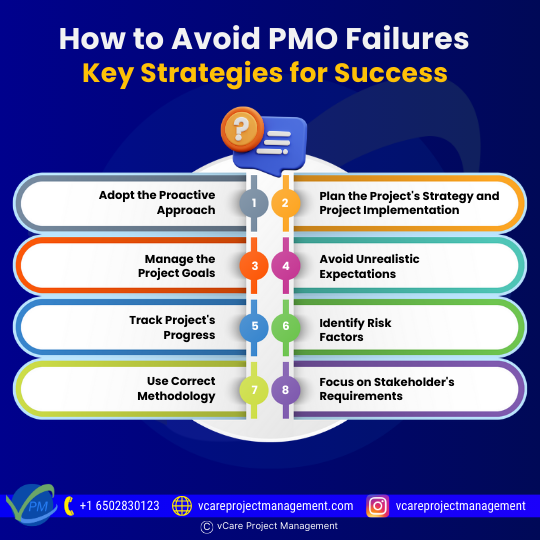
How to avoid PMO Failures
Here are the most common reasons why PMOs fail:
- Adopt the Proactive Approach
After many years, project managers gain the skills and knowledge needed for the current project from their experience. As a result, an experienced and highly skilled project manager is equipped to deal with customers and avoid project failure. If you are new to project management, consult a professional mentor to discuss your concerns and receive appropriate advice based on their experience. If you have project management experience, you should apply your skills and knowledge to the project and be aware of the common causes of project failure.
- Plan the Project’s Strategy and Project Implementation
The most important stage of any project is planning. Most of the time, proper attention is not given during the planning stage. If you plan properly, you will increase the project’s chances of success. After scheduling your project, use the Project Management Life Cycle to begin project execution.
- Manage the Project Goals
It would be best to document the project’s decisions, actions, and outcomes before beginning, during, and after completion. To avoid project failure, it is always necessary to ensure project deliverables and work appropriately with customer requirements. Never rely on understanding, verbal agreements, or memory for project implementation decisions.
- Avoid Unrealistic Expectations
Always set realistic expectations and time frames with stakeholders, team members, or customers to meet your project’s deadline. This move is related to the proper project start but goes deeper until completion. To avoid project failure, realistic expectations for team members must be set based on their capabilities. It would help if you encouraged them to work enthusiastically and push themselves beyond their comfort zone to meet the project’s objectives.
- Track Project’s Progress
Project planning will assist you in determining where your project should be now. In addition, you should know how much of the work has been completed, whether your work is on schedule, proceeding as planned, and so on. These three parameters govern any project and are critical in preventing project failure.
- Identify Risk Factors
The best way to avoid risk is to identify, analyze, and respond to risk factors. So, if you identify the risks and potential issues early on in the project, your project team can avoid them with appropriate actions. In addition, identifying and resolving risk factors will assist the project manager in lowering the likelihood of project failure. As a result, you can perform proper risk management and avoid project failure.
- Use Correct Methodology
One of the most important decisions a project manager must make is the methodology to use for project management. What you choose will have a significant impact on teamwork. However, each methodology has advantages and disadvantages depending on the project type and scope. Here are some top project management methodologies to consider.
- Waterfall method
- Agile/Scrum
- Hybrid approach
- Critical Chain Project Management
- Integrated Project Management Technique
- Critical Path Method (CPM)
All project management methodologies cannot be regarded as the best for all projects, so one can understand the project requirements and select the best option. The correct methodology will assist you in achieving the project goal within the specified time frame, thereby avoiding project failure.
- Focus on Stakeholder’s Requirements
As we all know, a project will only succeed if it meets its objectives and exceeds the expectations of its stakeholders. Therefore, to be successful in project management, all team members must be actively involved in the project and committed to its success. Devoting entails writing down the following stages:
- The competent initiative assists the team in implementing various tasks throughout the project life cycle.
- Adequate funding ensures the organization’s cost-generating department has enough money to fund the projects.
Final Thoughts
In today’s fast-paced and dynamic business environment, agile working methods might provide significant added value that should be noticed.
Digitalization is making projects more complex. As a result, the use of technology to manage projects is growing, and project teams must be cross-functional to achieve project goals. Agile project management provides an opportunity to respond quickly to new requirements and be more visible in the market. For organizations that use a traditional approach to project management, the transition to an agile PMO is part of their digital and agile transformation.
It should be noted that this is not an evaluation of “better” or “worse” methods. When used correctly, each project management method can reveal its strengths. It is critical to think about, use, and improve them.
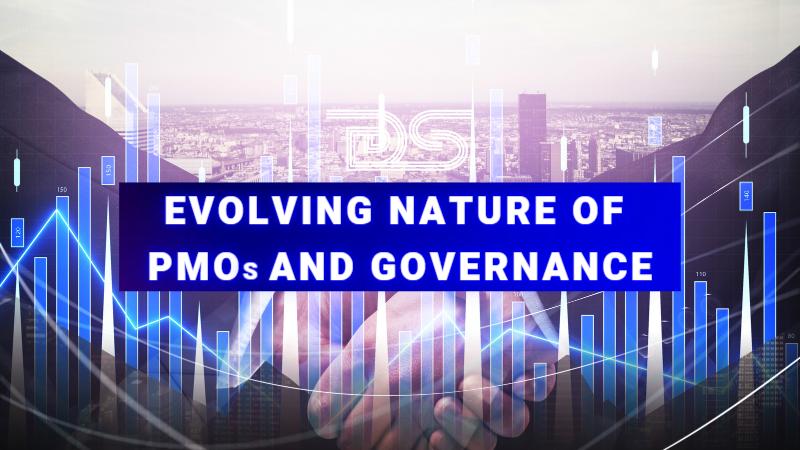
by DharamCW | Sep 8, 2023 | General
From a strategic standpoint, the PMO is critical in project management. Unlike project management, which focuses on the day-to-day operations of a project team, the PMO serves as a framework for project managers, offering PMO methodologies and templates for managing programs inside an organization. In addition, it manages the project management resources required to sustain and deliver projects.
Project management offices (PMOs) are evolving from purely administrative to strategic roles. They are rethinking PMO operations, adopting new technology, and implementing new project management operating models. The evolved PMO is a new PMO concept that is gaining traction. A creative, strategic, and adaptive PMO designed to help modern organizations deal with the volatility of today’s market conditions.

Functions Of A Project Management Office
Functions of a Project Management Office (PMO)
A project management office (PMO) is the foundation of a successful project management strategy in a business. It is a function that gives decision-support information but does not make choices.
A project management office (PMO) supports project delivery mechanisms by ensuring that all business change in a company is controlled. PMOs perform various duties, and their services depend on the department’s maturity and the PMO personnel’s talents. At its most basic, the PMO assists project management teams in making funding, prioritizing, and resource choices. The most mature PMOs provide the following:
1. Governance: The PMO ensures that the appropriate individuals make the correct decisions based on pertinent information. Audits or peer reviews, designing project and program frameworks, and maintaining accountability at all levels are all part of the governance role.
2. Transparency: The PMO delivers information as a source of truth. Information should be relevant and accurate to promote good decision-making and be presented to individuals understandably.
3. Reusability: The PMO fosters knowledge sharing. This aspect prevents project teams from reinventing the wheel and positions the PMO as the hub for lessons learned, templates, and best practices.
4. Delivery support: By minimizing bureaucracy and offering training, coaching, mentoring, and quality assurance, the PMO makes it easier for project teams to accomplish their duties.
5. Traceability: The PMO manages paperwork, project history, and organizational knowledge.
In reality, most PMOs will do various tasks and offer services tailored to the organization’s requirements.
How Business Agility Drives A Shift In Focus For Today’s PMOs
Forward-thinking companies are fast learning that “simply getting the job done” will not equip them for long-term company success. To be successful in business today, firms must provide products and services that satisfy their clients while constantly innovating to grow their markets.
Historically, PMOs were responsible for managing tactical operations that supported project development and implementation. Today’s Corporate leaders recognize that to stay ahead of the market; they need to exploit new possibilities while limiting unanticipated risks – this necessitates a new approach to planning, building, and delivery. Maintaining consistent levels of project success involves more than an organized strategy; it demands a company’s collective attitude to accept required disciplines while staying flexible enough to respond to changes in their business.
1. A major project fails — badly: When an expensive, strategic initiative fails in a competitive market, it compels a company to rethink its strategy. A third of the organizations polled cited a big failure as the impetus for shifting emphasis.
2. A project goes over budget: An underlying driver is cost reduction; project success at higher-than-expected costs decreases profitability and damages customer relationships.
3. A PMO aids a strategic project to succeed: Success, on the other hand, is a catalyst for change. Therefore, the following important reason for building a strategic PMO would be to capitalize on the momentum produced by the successful project.
4. Market competition forces stronger disciplines: Maintaining market share and growing at a controllable rate encouraged larger firms to create consistency to innovate. The capacity to pivot and explore possibilities prompted smaller businesses to establish a strategic PMO.
Key Factors to a Successful PMO Transformation
Established businesses and fast-growing firms are both adapting to changing business environments brought on by competition, acquisitions, developing technology, and new risks. As a result, the importance of alignment, built-in quality, transparency, and the capacity to execute across various project endeavors has never been greater. Innovative design thinking, continuous delivery, excellent quality, and a never-ending drive for improvement are some of the essential characteristics of a modern-day PMO. Here are some causes driving PMO evolution and the seven elements required to turn a typical PMO into a transformation management office (TMO).
Drivers behind the PMO Evolution
Due to increased external business environment constraints, businesses must achieve rapid and substantial value from their projects and initiatives. This aspect means shorter delivery cycles, the adoption of developing technologies, and regularly changed priorities for the PMO. To achieve this transition, the PMO must move its focus from project execution technique to value-driven business results. Change drivers are often aligned with three fundamental needs:

Drivers behind the PMO Evolution
1. Capacity and skills:
- Specific domain areas of technical expertise required
- Extra capacity required
2. Rapid Execution:
- Organizations require rapid execution to address immediate concerns
- No time to plan, but need to execute now to meet deadlines (e.g., regulatory compliance dates)
3. Innovation:
- Legacy project management no longer meets expectations
- Value focus, agility, quality, and continuous improvement are required

Transformation Management Office Critical Factors
Critical Factors to Consider
1. Leadership: TMO core values of alignment, built-in quality, transparency, and program execution must be completely embraced by leaders. They must adopt an agile mindset, emphasizing respect for people and culture, flow, innovation, and continuous development while cultivating a culture of trust and safety when setbacks occur.
2. Organizational Agility: Processes at the program and project levels must be improved to deliver value quickly while allowing companies to restructure and adapt to changing priorities.
3. Lean Portfolio Management: Goals for funding and execution must be aligned around workstreams that bring value to business priorities. Organizations may use this to optimize operations throughout their project portfolio. In addition, governance, monitoring, and decision-making for programs and projects should be decentralized to decrease overhead while boosting agility.
4. Enterprise Solution Delivery: The whole software development life cycle can be aligned with a DevOps methodology that refines and coordinates the work product across workstreams, supply chains, and suppliers to achieve and sustain continuous delivery.
5. Agile Product Delivery: Methods for delivering programs must begin with a customer focus and design thinking while aligning the continuous-delivery pipeline to a release cadence that provides optimum value to the customer.
6. Team and Technical Agility: Teams must be high-performing and cross-functional, with the knowledge and competence to design and execute high-quality solutions and work products aligned with customer-focused business goals.
7. Continuous-Learning Culture: Investing in being a learning organization is critical for employee transformation. Employees must be empowered to discover and uncover future value by embracing innovation and design thinking. Continuous improvement of solutions, processes, and products should be a priority at all levels of the business.
The evolving role of the PMO in digital transformation
Digital transformation has swept across organizations of all shapes and sizes to keep up with the growing expectations and needs of an increasingly digitized world. However, more people are learning that successful digital transformation entails transforming core cultures, structures, and techniques and integrating digital tools. Therefore, the function of the PMO in organizations must adapt to accommodate this shift as organizations evolve to accommodate this change.
According to a PWC study, 70% of organizations had or were working on a digital transformation strategy before the pandemic. Digital transformation may provide several benefits, ranging from better operational efficiency and product quality to increased customer satisfaction and lower development expenses.
However, PMOs have become linked with bureaucratic processes and unnecessary documentation. Their role must develop beyond the conventional limitations of “standards enforcers” to embrace their strategic role as change agents fully. Future PMOs must be at the forefront of emerging technology and implement various tactics that will allow the organization to make the most of available technologies.

Five ways the PMO drives digital transformation
Five ways the PMO drives digital transformation
1. PMOs can inspire and encourage change
The PMO’s role is to assist organizations in gaining the support of all key stakeholders for a digital transformation. Teams are more inclined to invest in digital projects if the transformation’s advantages are personal. PMOs may implement explicit feedback mechanisms to ensure that all important input is easily supplied, reviewed, and acted upon.
2. PMOs act as the strategic arm
PMOs must ensure that their digital transformation plan is consistent with the organization’s overall strategy. For example, investing in high-end software is pointless if your company is attempting to save money and merely needs essential project management tools. PMOs must also comprehend the strategic benefit of digital technology investments and be able to quantify, justify, and carry out plans.
3. PMOs provide support and insight
Digital transformation programs are frequently large-scale enterprise-wide undertakings that need ongoing support and higher-level knowledge to influence their development. For example, PMOs may assist employees via virtual portals with the help of a PPM solution while also gathering Big Data to help evaluate the new technologies’ success and efficiency.
4. PMOs properly manage transformations
Introducing new technology frequently entails forming new teams and learning new skills to ensure a successful adoption process. Managing digital transformation entails guaranteeing the availability of relevant resources, skills, feedback mechanisms, and data collection procedures. PMOs can monitor the full effect of digital transformation activities, manage possible bottlenecks or pressure spots, and optimize ongoing operations.
5. PMOs enable successful digital adoption
PMOs are essential in getting people excited about digital initiatives and driving further use of the tools or processes. PMOs may assist employees in understanding the value of digital technologies by delivering interactive demos and holding learning sessions. When more individuals utilize the application, there is more data to accurately analyze the overall performance of digital activities.
Project Governance and its components
Project governance is an oversight position that includes the project life cycle. It is tied to the governance model of the organization. It provides the project manager and team with structure, processes, decision-making models, and tools for effectively managing and controlling the project. Project governance is critical, especially for complex and risky enterprises. It defines, documents, and communicates consistent project processes to give a whole way of project control and success. It includes a framework for making project choices, defines roles, obligations, and liabilities for project completion, and controls the project manager’s performance.

Components of Project Governance
Components of Project Governance
According to PMI, eight project governance components offer real-world value:
1. Governance Models
The organization should develop a baseline of important aspects required for project governance based on the project’s scale, duration, complexity, risk, stakeholders, and relevance to the company.
2. Accountability and Responsibilities
The project manager’s primary responsibility is to define accountability and obligations. An organization’s operations will only be successful if accountability and obligations are adequately distributed. Therefore, the project manager must specify who is accountable, responsible, consulted, and alerted for each project’s deliverables.
3. Stakeholder Engagement
It is essential to thoroughly understand the project environment while setting the groundwork for your governance plan. The first stage is to identify all of the stakeholders. If even one stakeholder is excluded, it can disrupt the entire project and have a negative impact. One must identify stakeholders from various sources, including sponsors, suppliers, the project team, government boards, company owners, etc. The project manager must identify the stakeholders, their interests and prospects, and, most critically, how to interact with them.
4. Stakeholder Communication
The project manager must design a communication plan after identifying all stakeholders and describing their interests and expectations. A well-planned communication strategy provides all stakeholders with concise, efficient, and timely information.
5. Meeting and Reporting
Once the communication strategy has been properly designed, the project manager ensures that the optimal mix of meetings and reporting is in place. It is critical to design the communication strategy so that each stakeholder knows the mode and content of the communication and the owner, receiver, communication milestones, and decision gates. Furthermore, communication must be concise, accurate, and to the point.
6. Risk and Issue Management
Projects and programs are riddled with hazards and difficulties due to their uncertainty and unpredictability. It is challenging to forecast what will happen. Still, it is vital since a lack of preparation will throw the project team well behind schedule. Any project or program must begin with an agreement on identifying, categorizing, and prioritizing risks and concerns. How the danger or issue is handled is far more significant than the issue itself.
7. Assurance
Project assurance ensures that risks and concerns are addressed effectively and provides the indicators that provide delivery confidence. One of the most important aspects of assurance is developing metrics to provide a view of project success.
8. Project Management Control Process
It is the simplest component yet the most complicated to implement. Process control activities, metrics relevant to the project, and measurements are monitored and controlled. Also, this is a collaborative review; the management must monitor performance regularly and address any variances on time.
Creating project governance is more complex than it sounds. First, a significant investment is required when embarking on a new project. What’s more challenging is determining what advantages are linked with it. The following are four major advantages of project governance:
- Single point of contact
- Problem management and resolution
- Information dissemination and clear communication
- Outlines the roles, connections, and responsibilities of project stakeholders
Reinvent the PMO’s role in the digital age
The structure, provenance, and stakeholders of IT strategy, regulation, and management operations are changing dramatically due to digitization. As a result, the project management office, or PMO, must move its focus from project governance and delivery to digital transformation. According to a Gartner study, 87% of firms prioritize digitalization. Furthermore, today, 77% of an executive’s top priorities depend on technology.
As a result, PMOs are under enormous pressure to transform. But unfortunately, the project, program, and portfolio management processes they build and monitor are geared toward predictability and consistency rather than the speed and flexibility necessary to satisfy digital demand.
More flexible job descriptions and growing ownership of project management activities by business partners and other delivery professionals put traditional hierarchies and established PMO positions to the challenge. As a result, the PMO’s future role in digitization initiatives is established rather than for it since it usually needs to be considered in discussions about digitally driven changes to the IT operating model.
The traditional role of the PMO: Three advantages
Organizations are altering the function of the PMO in response to better support the enterprise’s digital aspirations. To accomplish so, they must examine possible activities critically through the prism of the PMO’s comparative advantages. The majority of PMOs have three main benefits, which are either inherent because of the PMO’s function or location or were developed as a result of experience:
1. A neutral enterprise perspective:
As capital allocation and portfolio priority approaches alter to give the financial flexibility necessary for digital work, the PMO’s objective, enterprise-wide perspective on demand, investment, and resource consumption, is more valuable.
2. The ability to operate via influence:
As organizational boundaries grow more flexible and who “owns” project management becomes less definite, influencing and empowering others, rather than direct ownership, becomes even more crucial.
3. Stakeholder insight:
As digitalization expands throughout the business and accounts for an increasing quantity of work, the number of first-time stakeholders and stakeholder complexity for each work item increases. Therefore, understanding the preferences of these many stakeholders and experiencing synthesizing their feedback becomes critical in producing results from digital work.
The PMO’s new role: Advancing digital ambitions
Leading PMOs are leveraging these advantages to shift the focus of their mission away from governance and delivery activities, embracing a strategy-over-governance and management-over-operations stance. Here are three approaches to altering the PMO’s role in the digital age:

Altering the PMOs role in the Digital age
1. Orchestrating delivery and team workflows
The PMO is well-suited to develop and promote interactions across increasingly different types of work and stakeholders due to its enterprise perspective and stakeholder insight. PMOs can play significant roles in driving the adoption of new delivery practices (e.g., Agile, DevOps) and will need to build systems for team collaboration across methodologies. This move entails identifying and managing interdependencies that might derail existing activity and lowering the effort necessary for interaction across teams, other governance roles, and third parties.
2. Developing and enabling digital talent
PMOs have expanded their roles in creating and fostering digital talent, adjusting career paths, and equipping project management professionals with the skills and techniques required to handle increasingly dynamic digital work. This initiative includes fostering new competencies such as product ownership, cultivating an enlarged network of project management practitioners, and providing targeted assistance for increasing business-managed projects.
3. Supporting digital transformation
Digitization is driving change in the IT operating model, with 52% of IT businesses utilizing or planning to use a new model centered on product lines. The PMO’s role in facilitating this transformation will be essential in the future. For example, the PMO may assist with enterprise-level capital allocation, design, and management of product line investment roadmaps, assess product line success, and manage the organizational transformation required when IT transitions to product lines. Aside from IT, the PMO will be asked to help implement digital business activities.
Final Thoughts
The future PMO will be more strategic and intricate than traditional approaches, emphasizing driving decision-making, execution, and outcomes while becoming more decentralized to interact with each workstream to achieve one common goal efficiently. Finally, PMOs will be more crucial than ever in addressing the challenges that organizations are now confronting. An effective transformation will need PMOs to act as the organization’s voice and face.
As the pace of digitalization increases, the PMO role will be put under increased pressure. As a result, PMOs are looking for methods to cut back on their time and effort on operational and governance tasks. Thus, PMO leaders must leverage their unique assets to change their focus from governance and delivery assistance to strategy and management activities that support digital projects.
Feel free to check out my discussion on this topic with Justin Buckwalter in YouTube
For any questions related to your Project Management career, training, and certifications, you can book an obligation free 15 minutes session with me by visiting https://bit.ly/2SbhTOK
You can subscribe to the vCare Project Management YouTube Channel to catch future videos of our Q&A series and certification success stories: https://bit.ly/2YF0wJl
You can subscribe to and follow my podcasts and interviews with Project Management Experts on YouTube at https://bit.ly/2NDY8wd





















Recent Comments